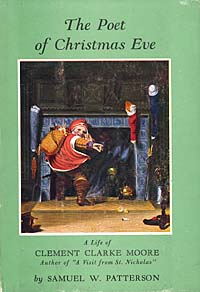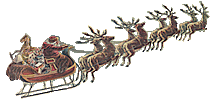A hundred and seven years ago on Christmas eve in New York Dr. Clement C. Moore went after a Christmas turkey and came
back witha poem which made him famous. Some months ago a real estate company purchased the old Clement Moore home at 429 West Twenty-third street in the
Chelsea district.
Recently they dedicated a sandstone block out of the old Moore homestead as a cornerstone for the new London Terrace apartment house
that is to rise on the site at a cost of 25 million dollars, says the New York Sun.
The borough of Queens, it is true, claims that Dr. Moore lived at Broadway and Laurel Hill boulevard in Elmhurtst, Queens and that the Chelsea home is spurious, but ten historians
prefer the Chelsea version to one who substantiates the claim of Queens.
'TWAS the Night Before Christmas" is the poem Dr. Moore is supposed to have written, and which he probably did write, although he termed it
a "frivolity" and would not admit paternity for a good many years. He was a good scholar and the compiler of the first Hebrew-English lexicon in this country, of which he
was considerably more proud than of the authorship of the Christmas poem, but the cornerstone ceremonies took place because of the poem,
and not because of the lexicon.
Despite the presence of Mayor Walker and former Governor Smith at the cornerstone laying, there is one city official who would have refused
to attend had he been invited. Borough President Harvey of Queens contests the right of Chelsea to claim the birthplace of the Christmas poem.
Squatting in the right of way of the Long Island-Jamaica subway in the borough of Queens route is another homestead claimed to have been
the inspiration of the world-famous Christmas poem, says the Brooklyn Eagle. In front of the mansion is an old well. Ivy covers part of the house.
Across Broadway is a modern office building. On another corner is a bank. A traffic light blinks balefully at night. Where the old Moore
homestead now stands it is planned to build a subway station.
"It would be ideal if the property could be turned back to the park department following completion of the wubway construction work," Harvey wrote.
"It may be possible to later restore the surface to its present park-like aspect, preserving intact the old homestead."
Part of the homestead as it now stands was erected in 1662. The "new house," or extension was built in 1776 and altered in 1857. The shrine
has several other bids for fame.
During the Revolution, General Howe, commander of the British, made his Long Island headquarters there. King William IV of England,
then the duke of Clarence, was a guest at the home during General Howe's stay.
The place, so its backers claim, was acquired by the Moore family in 1662, when Capt. Samuel Moore was made a grantee by the English king.
Clement Moore, who is said to have spent a large part of his boyhood and youth in the homestead, was born July 15, 1779. It was in that house,
Mr. Harvey and a number of historians of Queens Borough claim, that Dr. Moore was living in 1822 when he wrote "A Visit from St. Nicholoas."
Considerable more circumstantial evidence points to Dr. Moore's residence in Chelsea at the time, however.
There are several versions as to how Dr. Moore came to write the poem, but the "turkey story" is usually believed.
In 1822 Dr. Moore was 43 years old and professor of Hebrew and Greek at the General Theological seminary - a man with a long, thin face,
deep-set eyes and fierce eyebrows. He loved children, but it was not fashionable for doctors of theology and professors of Hebrew and Greek to be
known as sentimentalists.
According to the most familiar version of the story, the Moores were living "out in the country" in 1822 - on a quiet countryside outside of Greenwich Village -
and when Christmas eve came and Mrs. Moore started out to distribute baskets of food among her poorer neighbors, she discovered that she
lacked one turkey. Nothing would do but that Dr. Moore should go into the village and guy another turkey.
WRITTEN ON CHRISTMAS EVE
As the doctor tramped back through the quiet winter night, he had a sudden inspiration to write a poem about St. Nicholas for his children's bedtime story.
He hurried his footsteps, delivered the turkey to his wife, and shut himself up in his study. An hour passed - the children were calling for their father
to come out and tell them about St. Nicholas - and Dr. Moore emerged with a scrawled coipy of what he called "A Visit From St. Nicholas."
He read it to his youngsters in the kitchen of their old homestead that night and the children were delighted with St. Nicholas because "he had a broad face
and a little round belly that shook when he laughed like a bowl full of jelly."
"Just like Old Jan, right here on the farm!" they exclaimed, but Dr. Moore did not tell them that Old Jan, one of the Dutch residents of the
neighborhood, was indeed the model he had taken for his St. Nicholas.
Christmas passed and Dr. Moore forgot about the poem. The daughter of an old friend of the family happened to be at the house for the holidays,
and Dr. Moore obligingly copied the verse in her album. She took it back to her home in Troy, N.Y., and showed it to the editor of the Troy
Sentinel. The next Christmas season the Sentinel published the poem anonymously.
When a copy of the Sentinel came to Dr. Moore's attention he was upset. He protested. What if it became known that he wrote it? What
would people think - he, a theologian and a professor of Greek and Hebrew, writing frivolous verses for children!
FINALLY ACKNOWLEDGED IT
Before his death in 1863, after "'Twas the Night Before Christmas" had been reprinted in probably every newspaper in the United States and
was translated into most languages, he revised his opinion of the poem and took a slight amount of pride in it.
Few persons question Dr. Moore's authorship of the poem. Ten or fifteen years ago, however, the descendants of Henry Livingston, jr.,
a surveyor and landowner of Poughkeepsie, who lived at about the same period as Dr. Moore, advanced the theory that their ancestor it was who
wrote the poem. They had no direct proof of Livingston's authorship, however, and there has never been any considerable amount of controversy
on the subject.



![]() Copyright © 2014, InterMedia Enterprises
Copyright © 2014, InterMedia Enterprises